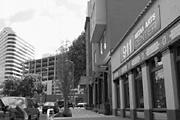THE DIGITAL BOOM has its detractors and beneficiaries in the fast-changing film world. Some eschew video, DV, streaming, and broadband, preferring to work with good old-fashioned filmstrips, cameras, and projectors. Others, like those who run the nonprofit 911 Media Arts Center, have elected to embrace the bytes and hertz of the moment. Gone from its humble space in the emerging Cascade neighborhood are the old flatbed film editing tables and gear (donated to Capitol Hill’s WigglyWorld).
Instead, 911 is now packed with computers, video decks, and digital editing consoles. Sawdust is also in the air, communications director Peter Mitchell explains, during an expansion project that will add some 2,000 square feet (increasing the center’s size by a third). “We’re gonna continue down this digital road,” he declares, noting how powerful, low-cost computer equipment and the Northwest’s high-tech boom have helped revitalize the exhibition-workshop space. “We’re very fortunate to live in Seattle,” he adds, describing how 911’s budget has quadrupled since 1995 to almost $1 million. (Some 60 percent of funding comes from grants and the dues of roughly 700 members, and 40 percent from renting its editing suites.)
After a period of rocky financing during the early ’90s, 911 has certainly benefited from our flush economic times. Microsoft recently donated an Avid Media editing system worth $30,000, and Wizards of the Coast gave $20,000. Then, Mitchell explains, after 911’s expansion project was approved by its board, the Warhol Foundation last month announced a $40,000 grant over two years. That money will allow construction of 911’s Hands-On Animation Laboratory (or HAL), mini-studio, and new audio suite—plus an artist-in-residence program.
IT COULDN’T COME at a better time, says Mitchell, “especially in a digital city like Seattle.” Kids working on Mac G3s and G4s at home regularly come in to dupe tapes, a recent indie DVD show ran to a packed house of 50, and a planned fall launch of Webflicks.org is intended to help local artists show their works to an even wider, wired audience. “That’s our reaction to the dot-com frenzy,” Mitchell laughs.
Housed in its present quarters since 1991, however, 911 faces an uncertain future in Cascade. Downtown is encroaching from the north, while South Lake Union’s burgeoning biotech corridor threatens from below. Then there’s all that land in the middle owned by Paul Allen. “I wish the Commons had gone through,” Mitchell sighs, since the master plan had included space for 911. Now, by contrast, it’s at the mercy of the market, with only three more years on its lease.
That’s the flip side of the high-tech boom: Even as 911’s thriving in the Silicon Forest, it could soon be priced out of the neighborhood.








